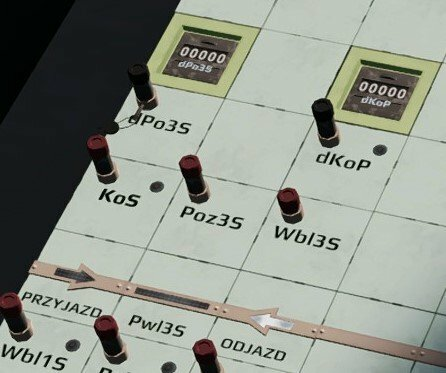Translations:How to operate relay line block equipment/30/en: Difference between revisions
(Importing a new version from external source) |
(Importing a new version from external source) |
||
| Line 1: | Line 1: | ||
==== ''Auxiliary change of direction'' ==== | |||
Interlockings with longer lines optionally have the possibility to change the permission in an auxiliary way. This auxiliary action is used if the regular change of direction cannot be used due to a malfunction. This can be the case, for example, if an automatic block section is displayed as occupied due to a technical malfunction. | |||
The interlocking on which the departure permission is indicated can carry out the auxiliary change of direction. To do this, the "A" or "AZK" button must be pulled. Now the direction of run on the line changes without the neighbouring signal box's involvement. Meanwhile, the arrival permission indicator flashes red. After the change of direction has been completed, the light changes to white. | |||
The neighbouring signal box, which now has the permission, must press the "Wbl" button in order to release the lock of the line. It is automatically activated as soon as the neighbouring signal box has changed the permission auxiliary. Now the neighbouring signal box can release a train. | |||
If there are trains running on the opposite track, "NO" or "NP" must be used here as well. | |||
[[File:1238179809 20221224162949 1(2).png|center]] | |||
Author of this guide: Oli806. Copied with permission from the author. | |||
Latest revision as of 01:58, 18 April 2024
Auxiliary change of direction
Interlockings with longer lines optionally have the possibility to change the permission in an auxiliary way. This auxiliary action is used if the regular change of direction cannot be used due to a malfunction. This can be the case, for example, if an automatic block section is displayed as occupied due to a technical malfunction. The interlocking on which the departure permission is indicated can carry out the auxiliary change of direction. To do this, the "A" or "AZK" button must be pulled. Now the direction of run on the line changes without the neighbouring signal box's involvement. Meanwhile, the arrival permission indicator flashes red. After the change of direction has been completed, the light changes to white. The neighbouring signal box, which now has the permission, must press the "Wbl" button in order to release the lock of the line. It is automatically activated as soon as the neighbouring signal box has changed the permission auxiliary. Now the neighbouring signal box can release a train. If there are trains running on the opposite track, "NO" or "NP" must be used here as well.
Author of this guide: Oli806. Copied with permission from the author.
